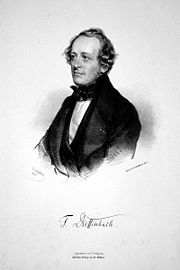
Johann Friedrich Dieffenbach
Encyclopedia

Surgery
Surgery is an ancient medical specialty that uses operative manual and instrumental techniques on a patient to investigate and/or treat a pathological condition such as disease or injury, or to help improve bodily function or appearance.An act of performing surgery may be called a surgical...
who specialized in skin transplantation and plastic surgery
Plastic surgery
Plastic surgery is a medical specialty concerned with the correction or restoration of form and function. Though cosmetic or aesthetic surgery is the best-known kind of plastic surgery, most plastic surgery is not cosmetic: plastic surgery includes many types of reconstructive surgery, hand...
. His work in rhinoplastic
Rhinoplasty
Rhinoplasty , also nose job, is a plastic surgery procedure for correcting and reconstructing the form, restoring the functions, and aesthetically enhancing the nose, by resolving nasal trauma , congenital defect, respiratory impediment, and a failed primary rhinoplasty...
and maxillofacial surgery established many modern techniques of reconstructive surgery
Reconstructive surgery
Reconstructive surgery is, in its broadest sense, the use of surgery to restore the form and function of the body, although Maxillo-Facial Surgeons, Plastic Surgeons and Otolaryngologists do reconstructive surgery on faces after trauma and to reconstruct the head and neck after cancer.Other...
. He endeavours comprehended subcutaneous operations such as tenotomy
Tenotomy
A tenotomy is a surgical act which involves the division of a tendon.When it involves the Achilles tendon, it is called a "Achillotenotomy".It has been used in the treatment of cerebral palsy.It has also been used for hammer toe....
, the surgical division of a tendon
Tendon
A tendon is a tough band of fibrous connective tissue that usually connects muscle to bone and is capable of withstanding tension. Tendons are similar to ligaments and fasciae as they are all made of collagen except that ligaments join one bone to another bone, and fasciae connect muscles to other...
. Before the discovery of blood typing and blood matching, Dr. Dieffenbach researched blood transfusion
Blood transfusion
Blood transfusion is the process of receiving blood products into one's circulation intravenously. Transfusions are used in a variety of medical conditions to replace lost components of the blood...
, about which he published Die Transfusion des Blutes und die Infusion der Arzneien in die Blutgefässe (1828). In 1839, Dieffenbach performed the first successful myotomy
Myotomy
Myotomy describes a surgical procedure in which muscle is cut.A common example of a myotomy is the Heller myotomy....
for the treatment of strabismus
Strabismus
Strabismus is a condition in which the eyes are not properly aligned with each other. It typically involves a lack of coordination between the extraocular muscles, which prevents bringing the gaze of each eye to the same point in space and preventing proper binocular vision, which may adversely...
on a seven-year old boy with esotropia
Esotropia
Esotropia is a form of strabismus, or "squint", in which one or both eyes turns inward. The condition can be constantly present, or occur intermittently, and can give the affected individual a "cross-eyed" appearance...
.
Originally, the student J.F. Dieffenbach studied theology
Theology
Theology is the systematic and rational study of religion and its influences and of the nature of religious truths, or the learned profession acquired by completing specialized training in religious studies, usually at a university or school of divinity or seminary.-Definition:Augustine of Hippo...
at the universities at Rostock
Rostock
Rostock -Early history:In the 11th century Polabian Slavs founded a settlement at the Warnow river called Roztoc ; the name Rostock is derived from that designation. The Danish king Valdemar I set the town aflame in 1161.Afterwards the place was settled by German traders...
and Greifswald
Greifswald
Greifswald , officially, the University and Hanseatic City of Greifswald is a town in northeastern Germany. It is situated in the state of Mecklenburg-Vorpommern, at an equal distance of about from Germany's two largest cities, Berlin and Hamburg. The town borders the Baltic Sea, and is crossed...
, and medicine at the Albertina university in Königsberg. From 1813 to 1815, he volunteered as a soldier in the Befreiungskriege
Napoleonic Wars
The Napoleonic Wars were a series of wars declared against Napoleon's French Empire by opposing coalitions that ran from 1803 to 1815. As a continuation of the wars sparked by the French Revolution of 1789, they revolutionised European armies and played out on an unprecedented scale, mainly due to...
(Napoleonic Wars) as a Jäger
Jäger (military)
Jäger is a term that was adopted in the Enlightenment era in German-speaking states and others influenced by German military practice to describe a kind of light infantry, and it has continued in that use since then....
. In 1818, he participated in student politics at Jena
Jena
Jena is a university city in central Germany on the river Saale. It has a population of approx. 103,000 and is the second largest city in the federal state of Thuringia, after Erfurt.-History:Jena was first mentioned in an 1182 document...
, which activity impelled his leaving Königsberg in 1820. In 1822, he became doctor of medicine in Würzburg
Würzburg
Würzburg is a city in the region of Franconia which lies in the northern tip of Bavaria, Germany. Located at the Main River, it is the capital of the Regierungsbezirk Lower Franconia. The regional dialect is Franconian....
and worked as a surgeon in Berlin. In 1824, he married Johanna Motherby. In 1832, he became professor at the university of Berlin, and in 1840 became director of the Clinical Institute for Surgery at Charité
Charité
The Charité - Universitätsmedizin Berlin is the medical school for both the Humboldt University and the Free University of Berlin. After the merger with their fourth campus in 2003, the Charité is one of the largest university hospitals in Europe....
Hospital. After his death in 1847, Bernhard von Langenbeck
Bernhard von Langenbeck
Bernhard Rudolf Konrad von Langenbeck was a German surgeon known as the developer of Langenbeck's amputation and founder of Langenbeck's Archives of Surgery....
(1810–1887) replaced Dieffenbach as director of surgery.

